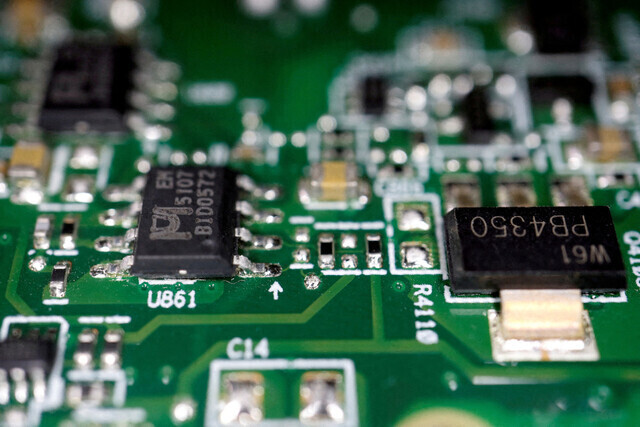While stock markets in the world’s major economies are hitting record highs, South Korea’s stock market remains flat.

A circuit board equipped with semiconductor chips. (Reuters/Yonhap News)
In Korea, the neologism “one-night beggar” was once widely used to describe people whose incomes did not change significantly but who felt poorer compared to those whose stock and real estate prices had soared.
Recently, the Korean stock market has begun to feel like it has become an “overnight beggar.” While stock markets in major global economies have reached record highs and even China’s stock market has recovered strongly from a three-year slump, the Korean stock market has remained flat, leading to a growing sense of relative poverty.
In particular, South Korea’s rapid impoverishment has been exacerbated by the global boom in artificial intelligence. Taiwanese stock prices, which are competing with South Korea to benefit from the AI cycle, have soared, intensifying the battle for market capitalization between South Korea and Taiwan. There have been fluctuations in the market capitalizations of Taiwan and South Korea before and after the spread of COVID-19, but the gap between the two countries’ market capitalizations has never been as wide as it is now.
As of May 23, Taiwan’s market capitalization is about 1.27 times that of South Korea. Considering that Taiwan’s nominal gross domestic product (GDP) in 2023 is expected to be only 44% of South Korea’s GDP, it is no exaggeration to say that South Korea’s stock market has become a beggar overnight.
The gap between South Korean and Taiwanese stocks has become even more pronounced in 2024. As of May 23, the KOSPI’s annual growth rate was just 2.5%, while Taiwan’s TWSE surged 20.5%. The widening gap in market capitalization between the two countries is largely due to the difference in stock prices of the two countries’ major stocks. Taiwan’s market index, TSMC, has surged nearly 50% so far in 2024, a rate of increase that is incomparable to that of Samsung Electronics’ stock price.
This suggests that South Korean semiconductor companies like Samsung are not benefiting as much as their Taiwanese counterparts from the AI cycle boom and U.S.-led restructuring of the semiconductor supply chain, contrary to previous expectations.
However, domestic semiconductor exports have been increasing sharply since the second half of 2023, leading to a recovery in the domestic economy. The Bank of Korea, which raised its 2024 GDP growth forecast to 2.1% from 2.5%, also cited the recovery of the semiconductor cycle as the reason for its decision.
The recovery of the semiconductor industry is encouraging for the Korean economy, but if Korea’s semiconductor industry does not urgently seek investment in technological innovation, it may become a frog in a boiling pot.
The world has entered a never-ending battle for semiconductor dominance, the Chip Wars, with the US, China and even the EU joining the fray, with the US and EU planning to support their industries with $81 billion in subsidies.
China, Japan, India, and Saudi Arabia are also actively participating in this war. South Korea has also declared its participation in the war by announcing a plan to provide 28 trillion won in support of strengthening the competitiveness of its semiconductor industry. It may be late, but this is good news.
However, it remains to be seen whether South Korea’s semiconductor industry, and therefore its stock market, can rise out of poverty overnight. To the winners will come the benefits. To win the semiconductor wars, South Korea needs to continue with a bolder and more aggressive industrial policy.
Park Sang-hyun, economist at High Investments & Securities
Questions or comments? [english@hani.co.kr]


